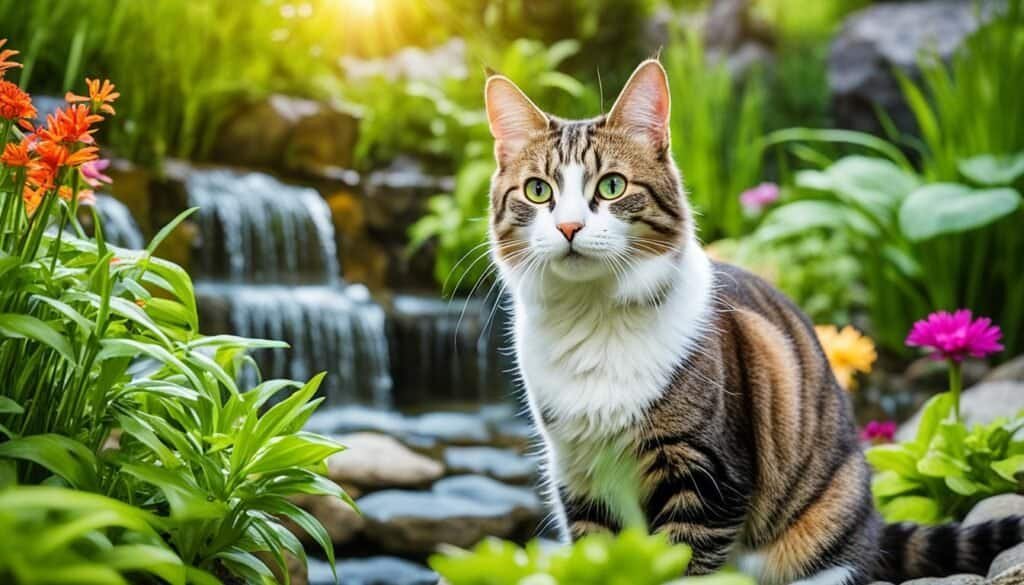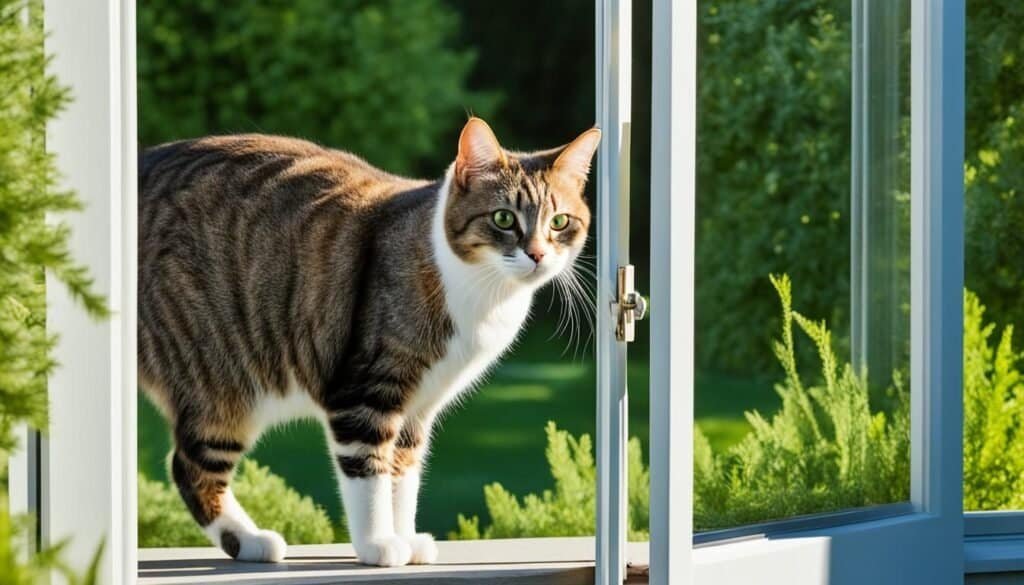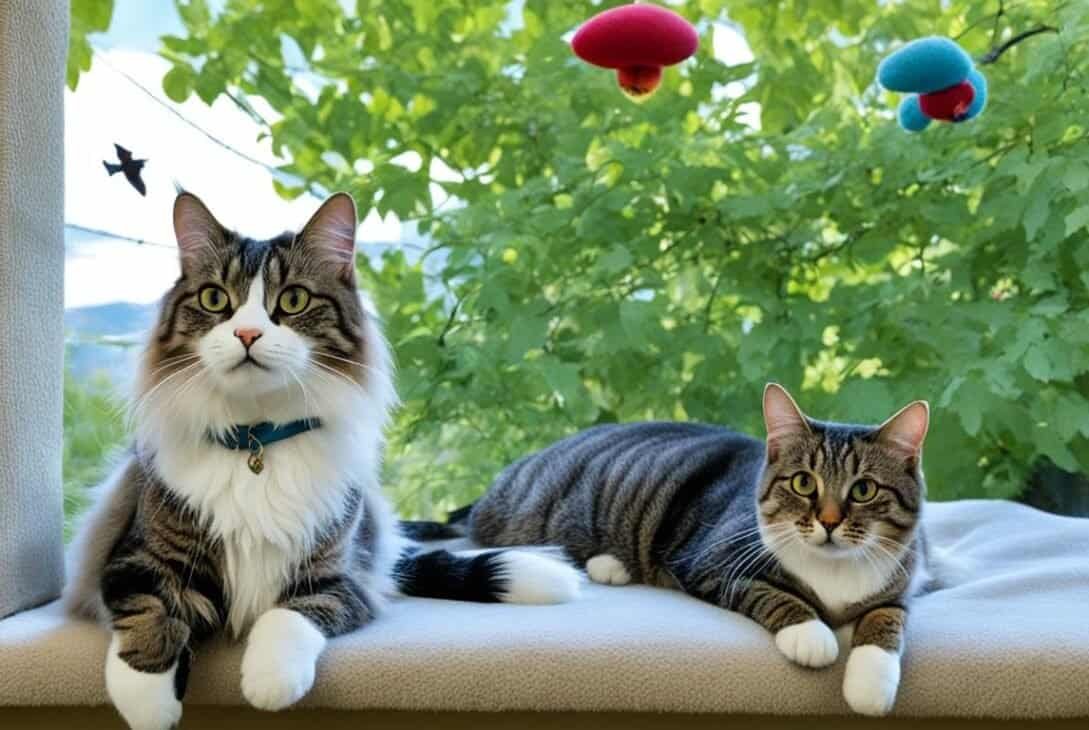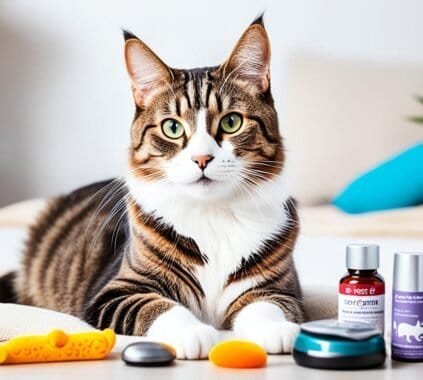Welcome to our comprehensive guide on indoor and outdoor cats. As cat lovers, it’s important to understand the key differences between these two living arrangements, as well as the impact they can have on our furry friends’ health and safety.
When it comes to cat behavior, there are distinct contrasts between indoor and outdoor cats. By gaining insight into these differences, we can make informed decisions about our cats’ living environments.
Indoor cats require special care to ensure their happiness and well-being. We’ll provide you with a variety of tips and ideas to keep your indoor cats content and mentally stimulated, creating a thriving indoor environment that meets their needs.
On the other hand, allowing cats to roam outdoors comes with safety concerns. In this article, we’ll dive into the precautions you should take to protect outdoor cats from potential dangers, while also exploring the benefits they may experience from their outdoor adventures.
Whether you are considering transitioning your cat from indoor to outdoor, or vice versa, we’ll guide you through the process and weigh the pros and cons associated with each living arrangement.
At the end of our exploration, you’ll have a well-rounded understanding of indoor vs. outdoor cat health, behavior differences, and the necessary precautions to maintain the well-being of your feline companions. Let’s prioritize the safety and happiness of our beloved cats!
Key Takeaways:
- Understanding the behavior differences between indoor and outdoor cats is crucial for providing them with the appropriate living environment.
- Indoor cats require specific care and environmental enrichment to keep them happy and mentally stimulated.
- Outdoor cats need precautions to ensure their safety and well-being in their adventurous lifestyles.
- Transitioning cats between indoor and outdoor living arrangements should be done carefully, considering the pros and cons of each.
- By prioritizing the health and safety of our cats, we can provide them with fulfilling and secure lives, regardless of their living situation.
Understanding Cat Behavior Differences
When it comes to cat behavior, there are distinct differences between indoor and outdoor cats. Understanding these disparities is essential for cat owners to make informed decisions regarding their cats’ living environments and overall well-being.
Indoor cats, as their name suggests, spend the majority of their time indoors. They are highly adaptable to an indoor lifestyle and often exhibit behaviors that reflect their environment. Indoor cats tend to be more relaxed, independent, and self-sufficient. They are content lounging around, engaging in grooming rituals, and observing the world from the safety of their indoor sanctuary.
In contrast, outdoor cats have the freedom to roam and explore their environment. They display a more active and adventurous nature, often engaging in hunting, climbing trees, and marking their territory. Outdoor cats are known for their curiosity and resourcefulness, as they navigate the outdoor landscape.
Understanding these behavior differences is crucial for several reasons. For indoor cats, it allows owners to provide enriching activities that keep them mentally stimulated and physically active. This can include interactive toys, scratching posts, and designated play areas. Additionally, creating opportunities for indoor cats to experience the outdoors safely, such as through enclosed outdoor enclosures, can help satisfy their natural instincts.
For outdoor cats, understanding their behavior enables owners to implement safety precautions that protect them from potential hazards. This can include providing a secure outdoor space, monitoring their activities, and ensuring they receive regular vaccinations and preventive healthcare.
Indoor Cat Care Tips
Keeping indoor cats happy and healthy requires providing them with a stimulating environment that caters to their natural instincts. Here are some practical tips and ideas to enhance your indoor cat’s well-being:
- Interactive Toys: Engage your indoor cat with interactive toys such as puzzle feeders, treat-dispensing toys, or wand toys. These toys help simulate hunting activities and provide mental stimulation.
- Vertical Space: Cats love to climb and perch. Invest in cat trees, shelves, or window perches to give your indoor cat access to vertical spaces. This helps satisfy their natural urge to observe their surroundings from an elevated vantage point.
- Scratching Posts: Provide multiple scratching posts or boards to fulfill your cat’s need to scratch and stretch. This helps them maintain proper nail health and prevents destructive scratching on furniture.
- Outdoor Enclosures: Consider constructing a secure outdoor enclosure or ‘catio’ where your indoor cat can enjoy fresh air and supervised outdoor access. These enclosures provide a safe environment for your cat to experience the outdoors.
- Window Views: Create window perches or clear viewing areas near windows where your cat can observe the outside world. This allows them to enjoy the sights and sounds of nature.
- Hideaways and Cozy Spaces: Cats love cozy and secluded spaces. Provide cozy hiding spots, cat beds, or enclosed cat houses where your cat can retreat and feel safe.
- Environmental Enrichment: Rotate toys, introduce new scents, and incorporate interactive games to keep your indoor cat mentally engaged. This prevents boredom and promotes overall well-being.
Remember to provide a balanced diet, regular exercise, and plenty of affection for your indoor cat. By implementing these indoor cat care tips, you can ensure that your feline friend leads a happy and enriching life indoors.
Outdoor Cat Safety Precautions
Allowing your cat to explore the great outdoors can be an enriching experience, but it’s important to prioritize their safety. Outdoor cats face various hazards, including traffic accidents, exposure to diseases, and encounters with aggressive animals. To protect your feline friend, follow these outdoor cat safety precautions:
- Ensure your cat is properly vaccinated and protected against common diseases.
- Consider installing a secure outdoor enclosure or catio to provide a safe space for your cat to enjoy fresh air and sunshine.
- Provide a well-fitting collar with ID tags, including your contact information, in case your cat gets lost.
- Spay or neuter your cat to prevent roaming and minimize the risk of fights or unwanted pregnancies.
- Supervise outdoor time, especially in unfamiliar environments, to prevent your cat from wandering off or getting into dangerous situations.
- Regularly check your yard for toxic plants or chemicals that may pose a threat to your cat’s health.
- Consider using a GPS tracker or a microchip to help locate your cat in case they go missing.
While there are risks associated with outdoor exploration, there are also benefits to allowing your cat outside. Outdoor cats often have more opportunities for exercise, mental stimulation, and social interactions with other animals. However, it’s crucial to balance these benefits with the need for safety and protection.
Remember, every cat is unique, and their suitability for outdoor adventures depends on their individual personality, health, and environment. It’s essential to assess the risks and take necessary precautions to ensure your outdoor cat can enjoy a happy and safe outdoor experience.

Transitioning Cats from Indoor to Outdoor (or Vice Versa)
Transitioning a cat from an indoor to an outdoor lifestyle, or vice versa, requires careful consideration and patience. It is essential to prioritize the safety and well-being of your feline companion throughout this process. Before making any changes, it’s important to understand the pros and cons associated with each living arrangement.
The Pros and Cons of Indoor Cats
- Pros:
- Indoor cats are generally safer from outdoor risks such as traffic accidents, predators, and exposure to diseases.
- They are less likely to encounter parasites and fleas.
- Indoor cats are typically more protected from extreme weather conditions.
- Cons:
- Indoor cats may be less physically active, which can lead to weight gain and potential health issues.
- They may experience boredom and lack mental stimulation without access to outdoor exploration.
When transitioning an indoor cat to an outdoor lifestyle, it’s crucial to gradually introduce them to the outdoors. Start by allowing supervised outdoor access in a secure and enclosed space, such as a screened porch or catio. This allows the cat to experience the sights, sounds, and smells of the outdoors while remaining protected.
The Pros and Cons of Outdoor Cats
- Pros:
- Outdoor cats have an opportunity for more physical exercise and mental stimulation through exploring their environment.
- They can engage in natural behaviors like hunting and climbing.
- Cons:
- Outdoor cats are exposed to various risks, including traffic accidents, diseases, poisoning, and attacks by other animals.
- They may encounter dangerous substances or plants in their environment.
If you decide to transition your cat from an outdoor to an indoor life, ensure their indoor environment is enriched with interactive toys, scratching posts, and climbing structures to compensate for the lack of outdoor exploration.

Conclusion
In conclusion, understanding the differences between indoor and outdoor cats is essential for responsible pet ownership. While both living arrangements have their pros and cons, it is crucial to prioritize the health and safety of our feline friends above all else.
Indoor cats can benefit from a stimulating environment that includes interactive toys, scratching posts, and plenty of vertical space. Regular playtime and mental stimulation are key to keeping them happy and healthy.
On the other hand, outdoor cats may enjoy the freedom to explore and satisfy their natural instincts. However, it is important to implement safety precautions such as providing a secure outdoor enclosure or harness training to avoid potential dangers like traffic accidents, exposure to predators, or ingestion of harmful substances.
Ultimately, the decision to keep cats indoors or allow them outside should be based on careful consideration of their individual needs, local regulations, and the specific risks in your area. Remember to consult with your veterinarian to ensure you are providing the best possible care for your beloved feline companion.
FAQ
What are the differences in behavior between indoor and outdoor cats?
What are some tips for taking care of indoor cats?
How can I keep my indoor cat entertained and enriched?
What safety precautions should I take for my outdoor cat?
What are the benefits and risks of letting my cat go outdoors?
How do I transition my cat from indoor to outdoor (or vice versa)?
Last modified: March 8, 2024













